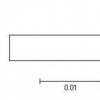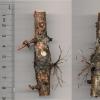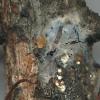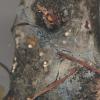
06-04-2025 17:28
 Alessio Pierotti
Alessio Pierotti
Tenuta di Tombolo (Parco regionale Migliarino San

04-04-2025 11:56
 Edvin Johannesen
Edvin Johannesen
These 0.2-0,4 mm diam. flat to slightly convex, gr

03-04-2025 21:31
 Francois Guay
Francois Guay
Hi, I found this interesting ascomycete on incuba

03-04-2025 18:26
Lennert GeesHello there!I found this species on dung of an unk

03-04-2025 16:45
Me mandan el material seco de Galicia (España),

01-04-2025 23:18
Yanick BOULANGERBonsoirRécolté par un ami sur dans un tas de bra

29-03-2025 09:08
 Martine Vandeplanque
Martine Vandeplanque
Bonjour.J’ai essayé d’étudier un Daldinia.Qu
 Hello everyone..
Hello everyone..I am finding a discomycete on small dead twigs of Larix laricina that have been broken off during a February windstorm here in coastal New Brunswick. It appears to be close to Lachnellula occidentalis (Hahn & Ayers) Seaver but the hymenium is not orange-buff to salmon orange as described by Hahn & Ayers, Seaver and other authors, and the apothecia are smaller. The ascospores measure 16.3-20.8 X 5.6-7.1 µm, which is close to the original description. So far I have not seen a description of IKI or Melzers reactions in L. occidentalis.
The description L. occidentalis in Nordic Macromycetes seems to differ from that of Hahn & Ayers in giving the ascospores as 18-20 X 7-9 µm and the paraphyses as monilioid. Perhaps it is not the same species.
Other species that might fit my material are L. hahniana (Seaver) Dennis, L. oblonospora Hahn & Ayers and L. calycina (Schumach.:Fr.) Sacc. in the sense of Fungi Rhen. 1206 as examined by Hahn & Ayers in their 1934 paper.
Can anyone offer some guidance here?
Dave?

L. willkommii is apparently always inamyloid and more parasitic, but I never understood whether it is really different from occidentalis. L. hahniana is said to be a synonym of occidentalis.
In Genbank there is only one sequence of willkommii though it is said to be harmful to Larix.
Here you can download my Lachnellula-key
Zotto

Martin, I appreciate your suggestion that I reexamine more asci in Lugol's. I have already looked at asci from three apothecia with the 100X oil objective with no sign of iodine reactions. The material is still fresh and living so I will examine some more asci, perhaps this time with KOH pretreatment.
Zotto, thank you for your comments and for the monograph of Lachnellula, which I didn't have. It is a great help and based on it I believe my material best fits L. occidentalis, although the iodine reaction remains problemmatic. I was particularly interested in the section discussing Lachnellula species in xeric habitats. I live in an area that has been described as a "boreal rainforest", where strongly desiccated branches and twigs are periodically exposed to fog and rain, even occasionally in mid-winter. This collection of L. occidentalis was on very small twigs (2-4 mm) that had blown down from high up on a large tree. The previous week they must have been frozen and totally dry.
Dave

Inamyloidity in occidentalis is not a problem, as I remember. All occurs in that species.
With the three available LSU-sequences of occidentalis/willkommii in GenBank I made an analysis, in conclusion I feel the three all belong to a single species.
Zotto

some workers claim that L. w. appears only in connection with symptomes of Larix-cancer. Such an example is presented here by Enrique:
http://www.asturnatura.com/fotografia/setas-hongos/lachnellula-willkommii-hartig-dennis-2/3075.html?
He obviously observed a positive iodine reaction in the wall of the ascus-tip only, but not in the apical ring (to make things even more complicated).
Did you see any signs of cancer-growth at your twigs, Dave?
Regards
Martin

Regards
Martin

The blue colour in Enrique's picture seems rather diffuse for one of these fungi. It looks more like something you would see in Peziza. Perhaps it is an artifact. Even some of the spores seem a little blue. I went back to my material and mounted it in Lugol's with KOH pretreatment and still saw no iodine reaction in any ascus. The base of the asci in my material is similar to Enrique's. The tree showed no symptoms of disease, other than being thoroughly dead.
Those records of L. occidentalis in GenBank still raise some questions. The two CBS strains of L. occidentalis and L. willkommii were both from Larix decidua, an exotic species in Massachusetts where they were isolated. Perhaps they are the same species but with one misidentified. The other isolate of L. occidentalis in your tree is from Nagano, Japan and perhaps a separate species. Lachnellula occidentalis is typified by a collection on a native species, Larix occidentalis from British Columbia,Canada. My collection is on Larix laricina, another native species on the Atlantic coast. The North Americal collections from native species don't seem to produce galls or other symptoms of disease. It might be interesting to sequence my material and see where it appears on the tree. It would also be nice to get some European sequences, particularly of L. willkommii. I wonder if too Hahn & Ayers cultures are still around.
Dave

I feel that little molecular work has been done on Lachnellula, which is astonishing, since there are parasites among them.
When I make a BLAST with the willkommii sequence, I get only one occidentalis and two Lachnellula sp., not even unidentified strains referrable to Lachnellula. Likewise with the ITS: only 5 strains of Lachnellula.
Zotto
I don't remember well this collection of L. willkommii. I'm sorry because I have any additional images, but my brief note on this species says: the asci are with croziers, not amyloid, not even hemiamyloid.
The blue shades are artificial.
Regards
Enrique

thank you for clearing this! I learned now that we have to test this ubiquitous fungus in every Larix stand more often! At least your collection seems to be connected to a cancer growth on the twig.
Regards
Martin

Earlier you asked if the trees on my property with Lachnellula had any cankers. I initially didn't see any, but Saturday I went out to inspect some other trees and found some typical cankers. Unfortunately the apothecia are immature and I cannot test the asci with Lugol's. Today I found a site from Prince Edward Island, our neighbouring province, stating that this disease was first seen in New Brunswick in 1980. Apparently it is a recent arrival. All this requires further investigation.
Dave

http://www.exoticpests.gc.ca/es-details/disease/1000096?
My home seems to be at the centre of distribution for this exotic species.

that makes you the principal source for "further inverstigations"... ;-)
I did search very often for cancer symptoms on twigs of Larix with Lachnellula, but I failed to find some, yet. Next season is close to come...
Are you aware of the thesis of Jean-Yves Blanchette, University of New Brunswick 2001? It is dedicated to the early state of infection, as probably in your case. I will send you a copy, if you don`t have it. Though reproduction of the pictures are lousy...
Regards
Martin

As I begin the wake up and become aware the presence of this fungus, I remember last September seeing many small trees of Larix laricina (local people call it "Hackmatack") that had suddenly died. I should check these for stem cankers.
Dave
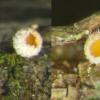
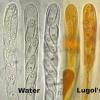
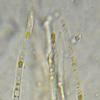
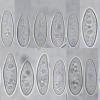
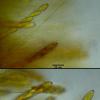
 Lachnellula-Baral-2008-0001.doc
Lachnellula-Baral-2008-0001.doc